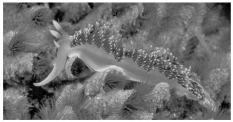Question 75
(Multiple Choice)
Use the following information to answer the questions below.
This nudibranch,a type of sea slug,has many reddish cerata on its dorsal surface,as well as two,white-tipped rhinophores located on the head.

The nontaxonomic term sea slug encompasses a wide variety of marine gastropods.One feature they share as adults is the lack of a shell.We might think,therefore,that they represent defenceless morsels for predators.In fact,sea slugs have multiple defences.Some sea slugs prey on sponges and concentrate sponge toxins in their tissues.Others feed on cnidarians,digesting everything except the nematocysts,which they then transfer to their own skins.Whereas the most brightly coloured sea slugs are often highly toxic,others are nontoxic and mimic the colouration of the toxic species.Their colours are mostly derived from pigments in their prey.There are also sea slugs that use their colouration to blend into their environments.
-Sea slugs can obtain nematocysts by preying on sea
A)anemones.
B)urchins.
C)daisies.
D)cucumbers.
E)lilies.
Answer